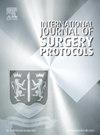Robotic vs. TaTME Rectal Surgery (ROTA STUDY) Matched Cohort Trial for Mid to Low Rectal Cancer Surgery Evaluation Trial in the Hands of an Experienced Surgeon
IF 1.1
Q3 SURGERY
引用次数: 1
Abstract
Background: Recent novel surgical techniques for resection of low rectal cancer have been introduced and these approaches have the potential to overcome anatomical limitations like obesity, narrow male pelvis and bulky and low tumours. Two of these procedures are robotic low anterior resection (RLAR) and transanal total mesorectal excision (TaTME). Both approaches have distinct advantages and limitations. There has been no head to head trial comparing RLAR and TaTME for patients with mid to low rectal cancer undergoing surgery by experienced surgeons. Previous studies looking at the oncological outcomes of either TaTME or robotic TME included many centres where the surgeons were on a learning curve and hence the true oncological outcomes and clinical benefits can not be measured accurately. Method: The inclusion criteria include experienced surgeons defined as minimum of 60 prior procedures with RLAR or TaTME. Successful oncological and clinical outcomes are defined as circumferential resection margin (CRM) ≥1 mm with limited postoperative morbidity (absence of Clavien-Dindo grade III–IV complications within 30 days after surgery). Local and distal recurrence rates with DFS over 3 years will be measured as primary outcome. Data will be collected prospectively and entered in a dedicated database. Discussion: The primary objective of this study is to conduct a multicentre prospective trial to investigate clinical outcomes, in particular disease free survival (DFS) in patients undergoing RLAR and TaTME. The additional goal is to investigate other efficacy measures, complications rates, health economic aspects and patient reported health related quality of life. This paper describes an important trial conducted in expert centres to establish the needed knowledge for a detailed comparison of outcomes for TaTME versus RLAR. This trial is the first comparative study, comparing TaTME and RLAR, seeking to establish foothold for tailor-made surgical treatment of low rectal cancer patients. Trial registration: The trial is registered in clinicaltrials.gov September 2019. Clinicaltrials.gov id: NCT04200027.机器人与TaTME直肠手术(ROTA研究)由经验丰富的外科医生进行的中低位癌症直肠手术评估试验的配对队列试验
背景:最近介绍了癌症低位切除术的新手术技术,这些方法有可能克服肥胖、男性骨盆狭窄和肿瘤体积大、体积小等解剖限制。其中两种手术是机器人低位前切除术(RLAR)和经肛门全直肠系膜切除术(TaTME)。这两种方法都有明显的优势和局限性。对于由经验丰富的外科医生进行手术的中低位癌症患者,尚未进行比较RLAR和TaTME的头对头试验。先前对TaTME或机器人TME的肿瘤学结果进行的研究包括许多外科医生处于学习曲线上的中心,因此无法准确测量真正的肿瘤学效果和临床益处。方法:纳入标准包括经验丰富的外科医生,定义为至少60例RLAR或TaTME手术。成功的肿瘤学和临床结果被定义为环切缘(CRM)≥1 mm,术后发病率有限(术后30天内没有Clavien-Dindo III–IV级并发症)。DFS 3年以上的局部和远端复发率将作为主要结果进行测量。将前瞻性地收集数据,并将其输入专用数据库。讨论:本研究的主要目的是进行一项多中心前瞻性试验,以调查接受RLAR和TaTME的患者的临床结果,特别是无病生存率(DFS)。额外的目标是调查其他疗效指标、并发症发生率、健康经济方面和患者报告的健康相关生活质量。本文描述了在专家中心进行的一项重要试验,以建立所需的知识,详细比较TaTME与RLAR的结果。这项试验是第一项比较研究,比较了TaTME和RLAR,旨在为低直肠癌癌症患者的定制手术治疗奠定基础。试验注册:该试验于2019年9月在clinicaltrials.gov上注册。Clinicaltrials.gov id:NCT04200027。
本文章由计算机程序翻译,如有差异,请以英文原文为准。
求助全文
约1分钟内获得全文
求助全文
来源期刊
自引率
0.00%
发文量
12
期刊介绍:
IJS Protocols is the first peer-reviewed, international, open access journal seeking to publish research protocols across across the full breadth of the surgical field. We are aim to provide rapid submission to decision times whilst maintaining a high quality peer-review process.

 求助内容:
求助内容: 应助结果提醒方式:
应助结果提醒方式:


